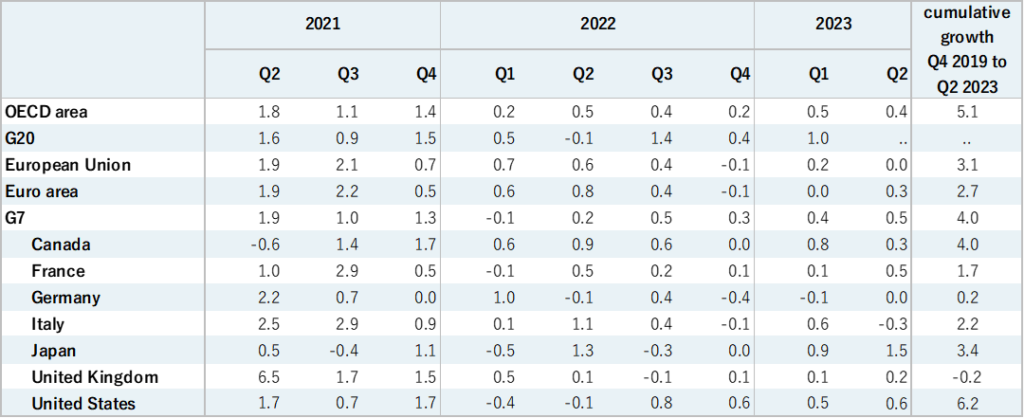Gross domestic product (GDP) in the OECD rose by 0.4% quarter-on-quarter in the second quarter of 2023, slightly down from 0.5% growth in the previous quarter, according to provisional estimates. This extends the consistent pattern of moderate growth observed since the first quarter of 2022.
In the G7, quarter-on-quarter GDP growth picked up slightly to 0.5% in Q2 2023, compared with 0.4% in Q1. This reflects a mixed picture among G7 countries. On the one hand, GDP growth increased noticeably in Japan (to 1.5% in Q2 2023, compared with 0.9% in Q1) and in France (to 0.5%, compared with 0.1%). Growth also accelerated, although more marginally, in the United States and the United Kingdom (to 0.6% and 0.2% in Q2, respectively, compared with 0.5% and 0.1% in Q1). On the other hand, GDP contracted in Italy in Q2 2023 (minus 0.3%) following a growth of 0.6% in Q1. Growth also slowed in Canada (to 0.3% in Q2, compared with 0.8% in Q1). Growth was flat in Germany in Q2, after contracting in the two previous quarters (Figure 1).
Several G7 countries have published details of the main factors driving the changes in GDP. In Japan, net exports (exports minus imports) were the main driver of growth, reflecting a 3.2% increase in exports and a 4.3% drop in imports, while private consumption contracted in Q2 (by minus 0.5%). Similarly, in France, net exports supported growth while private consumption contracted (by minus 0.3%). By contrast, in the United Kingdom, increases in private and government spending supported growth while net exports continued to be a dampening factor. The latter was also the case in Germany, reflecting a 1.1% drop in exports. In the United States, investment and private consumption contributed to GDP growth, although private consumption growth decelerated significantly (to 0.4% in Q2, compared with 1.0% in Q1). According to a preliminary analysis released by Italy, their GDP contraction reflected a reduction in domestic demand (including changes in inventories).
Of the OECD countries closest (geographically) to the war in Ukraine, GDP recovered strongly in Lithuania in Q2 2023, growing by 2.8%, compared with a contraction of 2.1% in Q1. In contrast, GDP contracted sharply in Poland in Q2 2023 (minus 3.7%) following 3.8% growth in Q1. GDP continued to contract in Hungary (minus 0.3%) for the fourth consecutive quarter.
Among other OECD countries for which data is available, Ireland recorded the strongest GDP growth (3.3%) in Q2, followed by Slovenia (1.4%) and Costa Rica (1.3%). By contrast, GDP contracted in ten OECD countries, most notably in Poland (minus 3.7%) followed by Sweden (minus 1.5%) and Colombia (minus 1.0%).
GDP in the OECD area exceeded its pre-pandemic (Q4 2019) level by 5.1% in the second quarter of 2023. In the G7, GDP exceeded its pre-pandemic level by 4.0%, although in the United Kingdom GDP still remained slightly below its pre-pandemic level (Figure 2). Elsewhere in the OECD, GDP was above Q4 2019 levels in Q2 2023 in all countries for which data was available except the Czech Republic. Spain, the OECD country most severely impacted by the pandemic (with a GDP contraction of 11.3% in 2020), exceeded its pre-pandemic level of GDP for the first time in Q2 2023[1], by 0.4%.
Figure 1 – Gross domestic product (quarter-on-quarter change)
Percentage change on the previous quarter, seasonally adjusted data

| Visit the interactive OECD Data Portal to explore this data |
* In Q2 2023, Germany and the European Union recorded zero growth. In Q1 2023, the euro area recorded zero growth.
Figure 2 – Gross domestic product (change since Q4 2019)
Cumulative growth rate (percentage), seasonally adjusted data

Table 1 – Quarterly (quarter-on-quarter) real GDP growth
Percentage change on the previous quarter, seasonally adjusted data

..: not available
Source: OECD (2023) Quarterly National Accounts (Database)
Table 2 – Quarterly (year-on-year) real GDP growth
Percentage change on the same quarter of the previous year, seasonally adjusted data

..: not available
| Data shown in this release was last updated on the 25th of August 2023. Methodological information: OECD GDP growth – Methodological Notes for OECD GDP News Release.G20 GDP growth – Methodological Notes for G20 GDP News Release.Access Data: OECD Database:OECD GDP News release underlying data; G7 countries and OECD aggregates, GDP and components, growth and contributions to growth; G20 countries and G20 aggregates, GDP growth.Contacts: For further information contact the OECD’s Media Relations Division on (33) 1 45 24 97 00 or e-mail [email protected]; for further information on data contact OECD’s Statistics and Data Directorate: [email protected].Next releases: G20 GDP growth – Q2 2023: 14 September 2023OECD GDP growth – Q3 2023: 21 November 2023 |
Source: OECD (2023) Quarterly National Accounts (Database)
[1] According to earlier estimates, released on the 23rd of June, Spain already exceeded its pre-pandemic level in Q1 2023. However, following subsequent revisions, made on the 28th of July, this actually only occurred in Q2 2023.









